18C.300.310 Streets and blocks.
A. Street Grid and Blocks.
1. Street Grid. A circulation plan must be submitted for review by the City as part of any development permit in the Station District unless waived by the City upon finding the project will not impact circulation or the enhancement of the public street grid. New development and redevelopment must demonstrate that the plan supports and accommodates the expansion of the public street grid to improve circulation for vehicles, pedestrians, and bicyclists.
2. Block Size. The maximum block size is four hundred (400) feet and the maximum distance permitted between public streets. New public street alignments shall be consistent with the regulating plan map. The City may approve modifications to the street alignments and waive the four hundred (400) foot maximum block size to take advantage of existing travel corridors, the location of utilities, and required improvements.
3. Private Streets. Private streets shall only be permitted when the City has determined there is no public benefit for circulation in the Station District. All private streets must be constructed to public standards.
4. Mid-Block Connections/Alleys. A minimum twenty (20) foot-wide mid-block connection (alley) shall be provided at the midpoint along each block face or every two hundred (200) feet. The mid-block connections shall be designed to accommodate service needs and for pedestrian use and be free from permanent obstructions.
5. Street Sections. The typical street sections provided below are the minimum requirements for the design of public streets. The City may approve modifications to the typical street section based on localized conditions and adjacent land uses. Modifications may include adding or removing on-street parking, wider sidewalks, loading zones, bicycle facilities, and transit accommodations.
6. Block Development. The minimum number of buildings per four hundred (400) feet of block frontage is four (4), or one (1) building per one hundred (100) feet, to create variety in the streetscape experience and support human-scale design. A single building may meet this requirement through building design and architecture that visually appears as multiple buildings. The City may approve modifications to this requirement based on site-specific conditions, including parcel ownership and configuration.
B. Street Types.
1. Mixed-Use Street. Mixed-use streets support a variety of activities and functions both in the public right-of-way and development along the street edges. Street-level retail is permitted, but not required, and a wider range of building frontage types are permitted, including street-level residential and office uses. Mixed-use streets also require pedestrian-oriented design and requirements may vary based on the location within the Station District.
2. Arterial Mixed-Use Street. Arterial mixed-use streets maintain the existing vehicle capacity and allow a range of land use and building frontage types and include surface parking lots.
3. Residential Street. Residential streets serve residential neighborhoods and include vehicle travel with sidewalks and bike lanes.
4. Green Street. Green streets include vehicle travel lanes, sidewalks, bike lanes, and open space for storm water management, landscaping, and gathering space.
C. Street Standards and Frontage Types. The following street standards are the minimum required and modifications to the standards may be approved by the City upon finding that the modification is consistent with the vision and objectives in LMC 18C.100.110, supports pedestrian-oriented design, and balances the need for traffic flow to minimize congestion.
|
Street type |
Sidewalk width |
Linear |
Forecourt |
Plaza |
Landscape |
Porch /Stoop /Terrace |
Parking |
|---|---|---|---|---|---|---|---|
|
10' minimum |
P |
P |
P/R1 |
P |
P |
X |
|
|
As determined by Public Works |
P |
P |
P |
P |
P |
P |
|
|
Residential Street |
8' minimum |
X |
P |
X |
P |
P |
X |
|
Green Street |
8' minimum |
X |
P |
X |
P |
P |
X |
|
Plaza Street |
12' minimum or shared street |
P |
P |
P |
P |
X |
X |
|
P=permitted, X=prohibited, R=required |
|||||||
|
1 Required when on a corner lot. |
|||||||
D. Street Sections. The following street sections show the basic elements of the streetscape for each of the streets highlighted in Station District. The City may approve modifications to the typical cross sections based on site-specific conditions including adjacent land uses, traffic management, parking needs, and right-of-way constraints.
1. Residential Street Typology. Many of the streets identified as residential streets do not have curbs, gutter, or sidewalks and there is a lack of definition between the public right-of-way and private property. Parking occurs along the street edge, often in gravel shoulders and without a consistent pattern. Established residential street right-of-way varies in the Station District. Figure 18C.300-2 shows a standard residential street section with a sixty (60) foot right-of-way that includes travel lanes, sidewalks, and bike lanes. In the future, bike lanes could be converted to on-street parking. Figure 18C.300-3 shows an eighty (80) foot right-of-way with native plantings on either outer edge of the right-of-way.
Figure 18C.300-2. Residential Street Typology – 60-Foot Right-of-Way
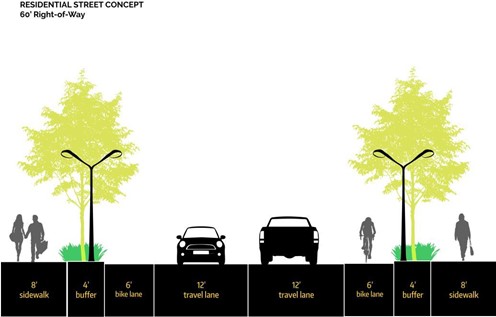
Figure 18C.300-3. Residential Street Typology – 80-Foot Right-of-Way

2. Green Street Typology. Kendrick Street SW connects to the Sounder Station to the south and to other neighborhoods to the north. The existing right-of-way width varies from between sixty (60) feet and eighty (80) feet and is an opportunity to integrate green street elements. The southern block of Kendrick Street SW appears to have been recently improved, so the following concepts focus on the blocks north of 111th Street SW as shown in Figures 18C.300-4 through 6.
Figure 18C.300-4. Green Street Concept No. 1 – 80-Foot Right-of-Way
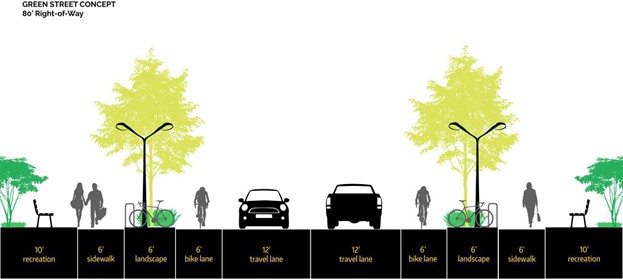
Figure 18C.300-5. Boulevard Concept – 80-Foot Right-of-Way
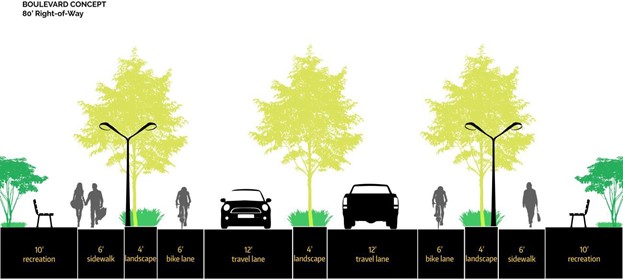
Figure 18C.300-6. Green Street Concept No. 2 – 60-Foot Right-of-Way
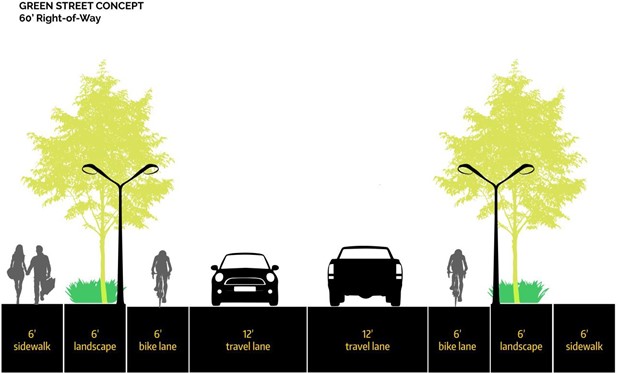
E. Plaza Street. Plaza streets are located along commercial and mixed-use zoning with active uses and may vary in width. Plaza streets are designed primarily for people and activities while allowing for vehicle access to adjacent properties. Plaza streets may have dedicated sidewalks or use a shared street design with appropriate traffic calming design features. Plaza streets should include high-quality materials, integrated landscaping and trees with open space, street furniture such as places for people to sit, bike parking, lighting, public art opportunities, and a flexible design that can support a variety of events and activities such as times where the street may be temporarily closed to vehicle traffic.
Figure 18C.300-7. Plaza Street Concept – 80-Foot Right-of-Way
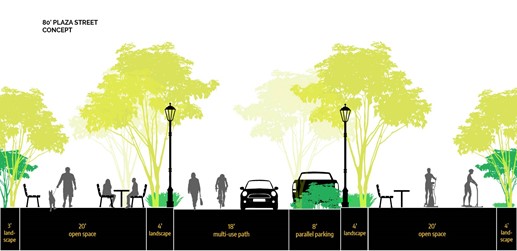
Figure 18C.300-8. Plaza Street Concept – 60-Foot Right-of-Way
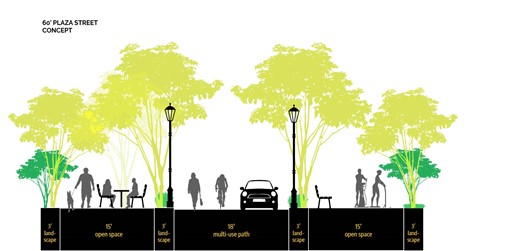
Figure 18C.300-9. Plaza Street Concept – 30-Foot Right-of-Way
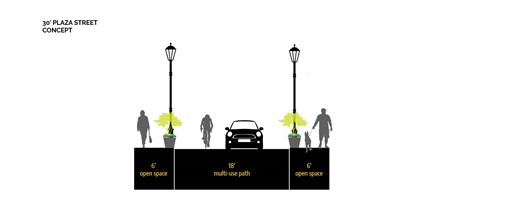
F. Alleys. Alleys are encouraged to provide secondary access to properties, de-emphasize parking lots, and promote continuous building frontages. Alleys shall meet Public Works engineering standards.
G. Weather Protection – Easements. Weather protection or building overhangs that extend over public rights-of-way may be permitted by the Community Development Director subject to execution of an easement and requirements for maintenance by the property owner or developer.
1. Access to existing and future utilities within and under the street and boulevard must be maintained.
2. Freedom of movement of existing and future vehicular and pedestrian activity must not be restricted.
3. Weather protection depth and percentage coverage shall be consistent with LMC 18C.400.410(A) for frontage types.
4. All overhead weather protection shall be placed at a height that relates to architectural features of the building and adjacent storefront weather protection, while offering effective protection from weather. Weather protection shall have a minimum vertical clearance of eight (8) feet, measured from the sidewalk, and should not be greater than twelve (12) feet above the pedestrian sidewalk level.
5. The slope of the weather protection feature shall allow for proper drainage and self-cleaning action of rain and wind. Materials used should be durable and require minimum maintenance.
H. When Required. Street frontages shall be implemented consistent with LMC 12.09.031. [Ord. 751 § 2 (Exh. B), 2021.]